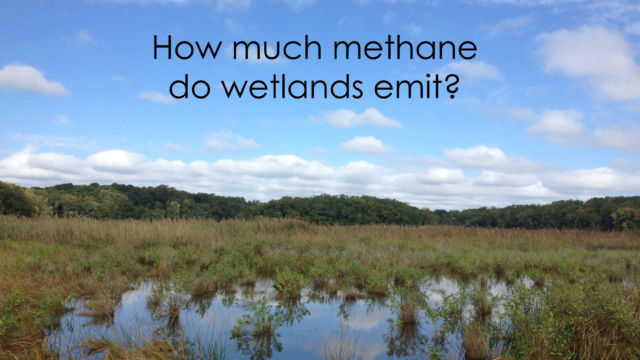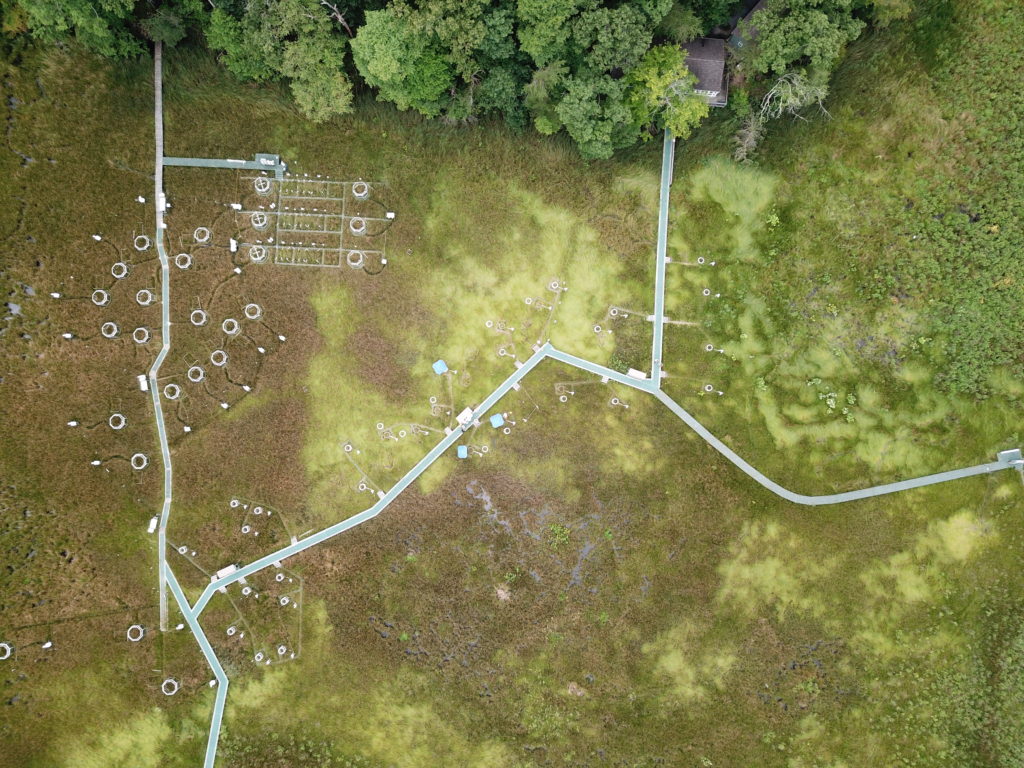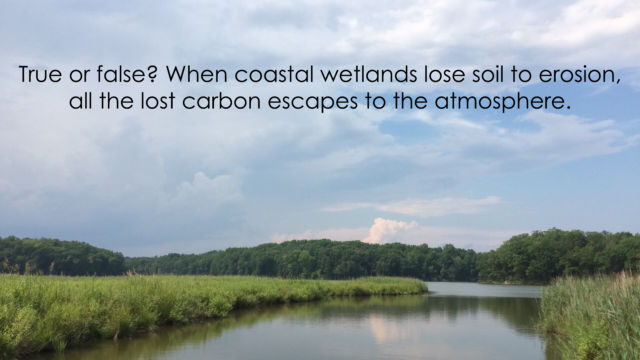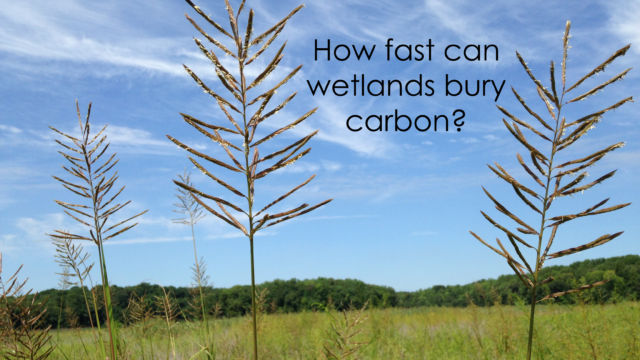A new team is using big data to change how the world calculates its carbon budget on the coasts
by Kristen Minogue

Left to right: Jorge Ramos of Conservation International (Credit: Laura Jaramillo/Conservation International); James Holmquist of SERC (Credit: Lauren Brown); David Klinges of SERC (Credit: SERC); Kathe Todd-Brown of the International Soil Carbon Network (Credit: Andrea Starr/Pacific Northwest National Laboratory).
There’s a gaping hole in Earth’s carbon budget. Scientists have known about it for years, but the data to balance the books have proven hard to find. The blank line is for coastal wetlands—ecosystems that could protect us not only from climate change, but hurricanes, pollution and a host of other environmental hazards.
“When we think of carbon storage or natural climate solutions, a lot of the time forests and trees come to mind,” said David Klinges, a research technician at the Smithsonian Environmental Research Center (SERC). “Because trees have a lot of mass, they store a lot of carbon. But what is not as publicly recognized is that soils—and other forms of plants besides trees—they also store carbon.”
Coastal wetlands have an especially good reputation as carbon-storing juggernauts. They can build new soil even as seas rise. And those soils, often loaded with carbon compounds, immediately find themselves buried under oxygen-starved saltwater, where their carbon can’t escape.
“It gets refrigerated and pickled all at once,” explained SERC research associate James Holmquist.
Knowing exactly how much carbon wetlands store could transform how countries solve climate change. If only we had enough data.
Holmquist and Klinges are spearheading an effort to find that data. Called the Coastal Carbon Research Coordination Network, they’re calling on scientists from Conservation International, the U.S. Geological Survey and other organizations across the U.S. to share any numbers on coastal wetland carbon. Along the way, their new team is upending some long-held assumptions about how carbon storage works in the real world.
Slideshow: Carbon Mythbusting
Hover over the slides to see some of the common assumptions and uncertainties the scientists with the Coastal Carbon Research Coordination Network are zeroing in on.


Hidden Figures
Ironically, the problem isn’t a lack of data. Last June Holmquist and other members published a Nature paper that scraped together data from nearly 2,000 soil cores (read more about the discovery here). Most weren’t in any official government database. The information is out there, but it’s scattered, like pieces of a jigsaw puzzle dropped from an airplane. The challenge is sharing it.
One obstacle is an understandable fear. A scientist’s data is her life’s work. If published online, an unscrupulous researcher could steal the data without acknowledging her, taking credit for years of labor.
“I used to work in the lab eight, nine, 10 hours a day,” Holmquist said. Weigh. Dry. Weigh. Burn. Weigh again. Repeat. Measuring dirt can be monotonous. “I remember what it was like doing that hard lab work.”
But even for scientists eager to publish data—and many are—there’s another barrier. Sharing data is hard.
“To make data publicly available, it needs to be clean and tidy. It’s a very tedious process,” Klinges said.
Sharing data takes more than posting numbers online, explained soil scientist Kathe Todd-Brown, data coordinator for the International Soil Carbon Network. Researchers need to pick a format any software can handle. It needs metadata, or “data about the data”—who collected it, when and where, or image resolutions. And it needs to be legible. Many stretched-thin scientists don’t have the time or expertise to tackle it.
Fortunately, Klinges and other network members can help with the more mind-numbing aspects of data processing. Klinges has been pulling all their info together in a Data Clearinghouse, which he calls “our one-stop shop for coastal carbon data.” Earlier in 2019, they created a companion interactive map where users can both visualize and download the data.
They’ve also built a safety net for scientists nervous about leaving their data out in the open. If a scientist gives data to the Coastal Carbon Research Coordination Network, the network’s managers agree not to publish anything until that scientist first publishes it in her own paper.
“Our willingness to embargo data until researchers are ready is our demonstration of the trust that scientists can place in us,” Klinges said.

Aerial view of SERC’s Global Change Research Wetland, where scientists run futuristic global change experiments. (Credit: David Klinges/SERC)
Wading Into the Unknown
We can’t afford to ignore wetlands in our plans to solve climate change. Yet there’s still much we don’t know, and several common assumptions are oversimplified or flat-out wrong. Most experts are aware of the shortcomings. But when the highest panel of climate scientists in the world—the Intergovernmental Panel on Climate Change—issues reports, they have to base their estimates on something.
Throwing uncertainties and assumptions into sharp relief, and offering alternatives, is the coastal carbon scientists’ second mission.
Methane sits at the top. It’s an even more powerful greenhouse gas than carbon dioxide: 25 times more by conventional estimates. But the coastal carbon network suspects it’s even higher, possibly 45 times.
Some wetlands emit methane naturally. How much remains a big unknown. So far, scientists know freshwater wetlands emit more methane than salty ones. Coastal wetlands (because they’re on, well, the coast) lean saltier. Unless, Holmquist pointed out, they’ve been altered.
“A lot of these wetlands are artificially freshened,” Holmquist said. However, if coastal wetlands are being made fresher, we can reverse that process. Reconnecting coastal wetlands to the sea would make them emit less, even zero, methane. “It makes the restoration benefit a lot higher,” he said.
Then there’s the question the team was most ready to pounce on: How fast can coastal wetlands bury carbon? Are they the same everywhere?
In 2018, the network convened a smaller working group to dig into that. They shared data virtually for months before meeting face-to-face last December. Of course, having loads of data didn’t make their job easy.
“Typically when people talk about big data, they’re talking about sheer volume of data,” said Todd-Brown, a working group member. But there are lots of ways to measure soil carbon. “In soils, your data is wide as opposed to just big. You have a huge diversity of data.”
Right now, the group suspects sea-level rise and plant life may shape how fast wetlands bury carbon. Later in 2019, a second group will start drilling into the other big uncertainty: methane.

Kathe Todd-Brown works on a mathematical model on how microbes break down organic compounds in the soil. (Credit: Andrea Starr/Pacific Northwest National Laboratory)
A Question of Values
Demystifying wetlands is about more than correcting climate change reports. Real people make their homes around coastal wetlands and depend on them for their livelihoods.
“People depend on these ecosystems for many reasons. Fisheries, ecotourism, harvesting, coastal defense from waves and storms,” said Jorge Ramos, a carbon scientist with Conservation International, which helped co-found the network. Carbon often isn’t the first thing land managers consider when deciding about conserving wetlands. But that data offers a bonus, especially if it can translate into blue carbon credits—credits for carbon in coastal systems like wetlands.
“We want to be able to prove that we’re not just another research database,” he said. “We actually want to be useful. We want to show examples of how the data is helpful and contributing to protecting these ecosystems.”
For Holmquist, the coastal carbon network represents what the future of science needs to be.
“In the past, science has been very tribal. It’s been very individual-focused, very lab-focused,” he said. Solving planetary problems like this requires more collaborative thinking. “I think that while working together, we’re going to move a lot faster and a lot further than we could working as individuals.”
Want to go deeper? Gain access to the Coastal Carbon Research Coordination Network and its data at https://serc.si.edu/coastalcarbon
Read more:
800 Million Tons of Blue Carbon May Lie Buried in U.S. Tidal Wetlands
As Sea Level Rises, Wetlands Crank Up Their Carbon Storage
The Blue Carbon Market Is Open
8 Ways Nature Can Help Us Conquer Climate Change



